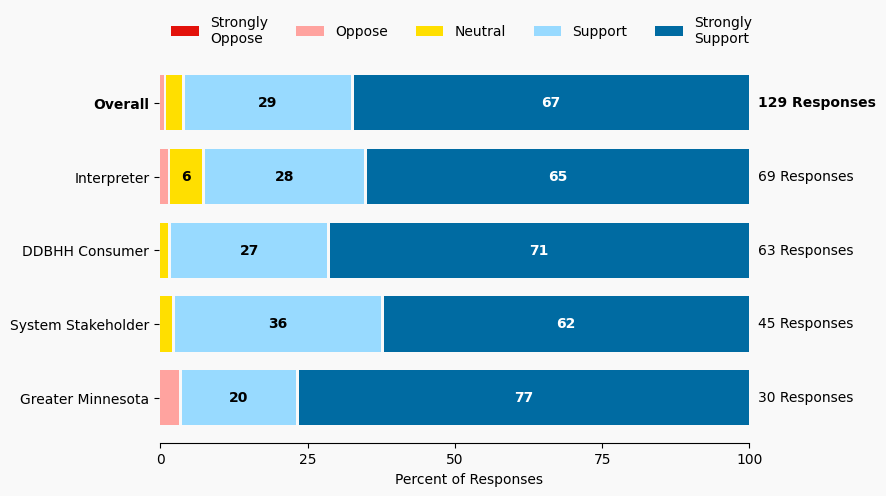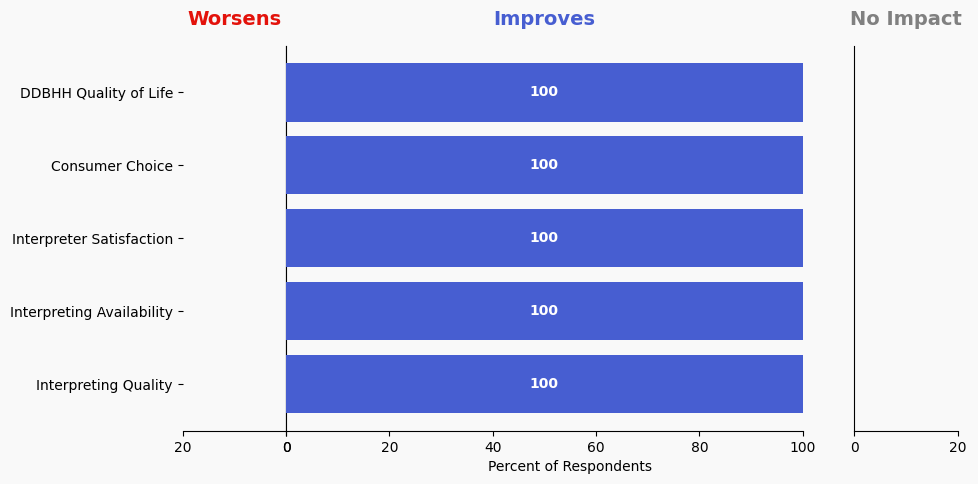58 Advertise Interpreting in Greater MN as an Attractive Career to Recruit Interpreter Training Program (ITP) Students
Issue: Interpreter shortage; amplified in Greater Minnesota
Proposed Solution: In addition to State Services’s grant programs to support Greater Minnesota interpreters, use the same techniques for recruiting ASL students and ITP students from mainstream audiences, high schools and career fairs in Greater Minnesota. Coalition, in partnership with State Services and relevant ITPs, advertise the ITP options and mentoring/internship options that fit the lives of individuals who do not have access to Twin Cities resources.
Expected outcome: Increased number of available interpreters in Greater Minnesota.
Who is impacted: ASL students, interpreter training program, consumers, hiring entities in Greater Minnesota
Timeline: 6 months
Note: For those needing training, consider University of Northern Colorado or other low cost/no cost virtual ITP options. For those needing continued professional development, internships or mentorships, consider 1) State Services grants and 2) establishing a program to mirror Colorado’s rural interpreter program (Colorado Commission for the Deaf invested in a rural interpreter PD program, 18 months with compensation and mentoring).

Summary of Support Image Description
The stacked bar charts show how respondents rated their level of support and the total number of responses. The percentage for the five support levels is shown from left to right: Strongly Oppose (Dark Red), Oppose (Light Red), Neutral (Yellow), Support (Light Blue), and Strongly Support (Dark Blue).
Respondents may identify with multiple subgroups. The overall level of support is:
Overall
Strongly Oppose: 0%
Oppose: 1%
Neutral: 3%
Support: 28%
Strongly Support: 67%
Click to see the detailed image description for each subgroup.
Interpreter
Strongly Oppose: 0%
Oppose: 1%
Neutral: 6%
Support: 28%
Strongly Support: 65%
Greater Minnesota
Strongly Oppose: 0%
Oppose: 3%
Neutral: 0%
Support: 20%
Strongly Support: 77%
DDBHH Consumer
Strongly Oppose: 0%
Oppose: 0%
Neutral: 2%
Support: 27%
Strongly Support: 71%
System Stakeholder
Strongly Oppose: 0%
Oppose: 0%
Neutral: 2%
Support: 36%
Strongly Support: 62%
Overview of Respondents Opting for In-Depth Solution Analysis
After indicating their support level, 2% of the 129 respondents opted in to further assess whether the solution would worsen or improve on five metrics. Of the opt-in reviewers (3 respondents), 100% supported the solution, 0% were neutral on the solution, and 0% opposed the solution.
The remaining 126 respondents did not opt in to further assess the solution. Of these people, 96% support the solution, 3% were neutral on the solution, and 0% opposed the solution.
Reviewer Evaluation of Solution Effectiveness

Solution Effectiveness Image Description
The stacked bar charts show how respondents assessed the effectiveness of this solution based on five metrics. For each metric, the percentage of respondents is shown from left to right: Worsens (Red), Improves (Blue), No Impact (Gray).
DDBHH Quality of Life
Makes It Worse 0%
Makes It Better 100%
No Impact 0%
Interpreter Satisfaction
Makes It Worse 0%
Makes It Better 100%
No Impact 0%
Consumer Choice
Makes It Worse 0%
Makes It Better 100%
No Impact 0%
Interpreting Availability
Makes It Worse 0%
Makes It Better 100%
No Impact 0%
Interpreting Quality
Makes It Worse 0%
Makes It Better 100%
No Impact 0%
Reviewer Feedback and Insights
Interpreter
Comments from Interpreters suggest that there are successful programs in other states such as Colorado, and that Minnesota has the potential to develop similar or better programs with increased funding and support. Comments suggest ensuring that recruitment efforts include DIs (Deaf Interpreters) and the BIPOC community, not just Greater MN. Concerns also highlight that Greater MN needs better advertising and support for interpreters, as some areas lack resources and Deaf communities, which can deter potential interpreters from moving there. The comment emphasizes marketing Greater Minnesota to the right demographic, highlighting the opportunities and resources available.
Deaf, DeafBlind, Hard of Hearing
No comments were submitted.
System Stakeholder
Comments from System stakeholders emphasize the need to reach out to ASL classrooms to present interpreting as a career choice, not just a language to learn. Suggestions include collaborating with school districts to Comments from System stakeholders emphasize the importance of demonstrating ASL interpreting as a viable career choice to students, not just a fun language to learn. One comment suggests collaborating with schools to bring interpreters into the classroom and offering job shadowing opportunities to high school students, recruiting students from Greater MN and offering ITPs (Interpreter Training Programs) in those areas. Another comment raises concern about whether Greater Minnesota can support more interpreters with living wages.
PREVIOUS SOLUTION
57 Seek or Create a Grant to Assess Medical VRI Services Statewide
Issue: Standards are nonexistent for VRI in healthcare settings
NEXT SOLUTION
59 Enhance Broadband Internet Access in Greater Minnesota
Issue: Broadband internet access in rural areas is often insufficient for high quality video capabilities needed for effective interpreting via video.
Leave a Reply